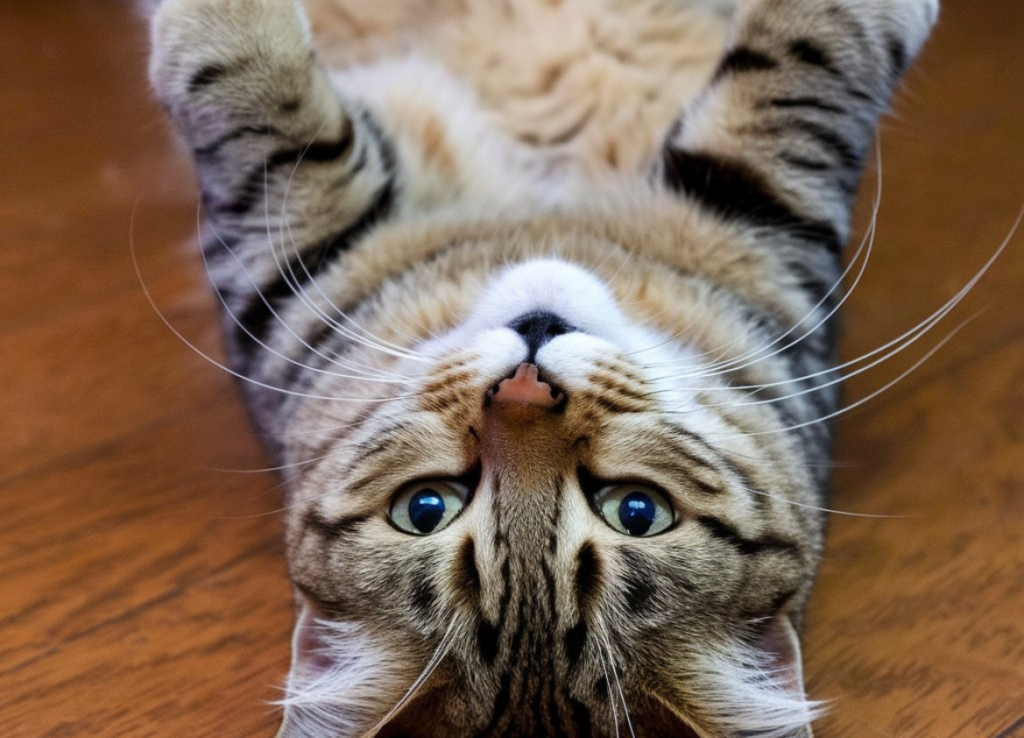As a cat owner and animal enthusiast, I’ve always been intrigued by the quirky behaviors of our feline friends. One particular action that never fails to catch my attention is when cats turn their heads upside down. It’s a peculiar and adorable sight that often leaves us wondering about its meaning. In this article, I’ll dive deep into the reasons behind this fascinating feline behavior, exploring the science, psychology, and communication aspects of why cats turn their heads upside down.
Key Takeaways:
- Cats turn their heads upside down for various reasons, including relaxation, playfulness, and communication.
- This behavior is often a sign of trust and contentment in their environment.
- Understanding feline body language helps strengthen the bond between cats and their owners.
- Upside-down head positions can also serve as a form of scent marking and territorial behavior.
- In some cases, this action may indicate a medical issue that requires veterinary attention.
Why Do Cats Turn Their Heads Upside Down?
As a cat parent, I’ve observed my furry companions engaging in this behavior countless times. Cats turn their heads upside down for several reasons, and understanding these motivations can help us better connect with our feline friends.

- Relaxation and Contentment
One of the primary reasons cats turn their heads upside down is to express relaxation and contentment. When a cat feels safe and comfortable in its environment, it may roll onto its back and tilt its head upside down. This position exposes the cat’s vulnerable belly area, which is a sign of trust in its surroundings and the people nearby.
I remember the first time my cat, Whiskers, rolled over and turned his head upside down while I was reading on the couch. It was a heartwarming moment that made me realize how much he trusted me and felt at ease in our home.
- Playfulness and Attention-Seeking
Cats are naturally playful creatures, and turning their heads upside down can be a way to initiate playtime or seek attention from their human companions. This behavior is often accompanied by dilated pupils, a swishing tail, and paw movements, all indicating a playful mood.
During my years as a cat owner, I’ve noticed that my cats often use this position to entice me to engage in play. It’s their way of saying, “Hey, look at me! I’m ready for some fun!”
- Scent Marking and Territory
Believe it or not, cats have scent glands on their faces, including their cheeks and forehead. When they turn their heads upside down and rub against objects or people, they’re actually marking their territory and leaving their scent behind.
I’ve observed my cats doing this on furniture, doorways, and even my legs. It’s their way of claiming ownership and creating a familiar environment that smells like them.
- Stretching and Physical Benefits
Turning their heads upside down can also be part of a cat’s stretching routine. This position allows them to elongate their neck muscles and spine, providing a satisfying stretch that helps maintain flexibility and muscle tone.
As someone who practices yoga, I can relate to the importance of a good stretch. It’s no wonder our feline friends incorporate this movement into their daily routines!
- Communication with Other Cats
In multi-cat households, turning the head upside down can serve as a form of non-verbal communication between felines. It can signal submission, friendliness, or an invitation to play.
When I adopted a second cat, I noticed how they used this behavior to establish their relationship and communicate their intentions to each other.
- Cooling Down
During hot weather, cats may turn their heads upside down to expose their belly and neck area, which have less fur coverage. This helps them regulate their body temperature and cool down more efficiently.
Living in a warm climate, I’ve seen my cats use this technique during summer months to beat the heat.
- Seeking Belly Rubs (Sometimes)
While not all cats enjoy belly rubs, some may turn their heads upside down as an invitation for gentle petting. However, it’s essential to approach with caution, as even cats who enjoy belly rubs may suddenly become overstimulated and react defensively.
I learned this lesson the hard way with my first cat, who would sometimes invite belly rubs only to playfully swat at my hand moments later.
- Medical Considerations
In rare cases, persistent head tilting or turning upside down may indicate an underlying medical issue, such as an ear infection, vestibular disease, or neurological problem. If you notice your cat frequently tilting its head or showing signs of discomfort, it’s crucial to consult with a veterinarian.
As a responsible pet owner, I always keep an eye out for any unusual or excessive behaviors that might warrant a trip to the vet.
Understanding Feline Body Language
To fully appreciate why cats turn their heads upside down, it’s essential to understand the broader context of feline body language. Cats communicate through a complex system of vocalizations, facial expressions, and body postures. The upside-down head position is just one piece of this intricate puzzle.
Facial Expressions:
- Slow blinking: A sign of affection and trust
- Dilated pupils: Indicates excitement or fear
- Ears position: Forward for interest, flattened for aggression or fear
Body Postures:
- Arched back: Can indicate fear or aggression
- Tail position: Upright for happiness, puffed for fear or aggression
- Kneading: A sign of contentment and relaxation
By observing these cues alongside the upside-down head position, we can better interpret our cats’ emotions and intentions.
The Evolutionary Perspective
From an evolutionary standpoint, the behavior of turning the head upside down may have roots in wild cat behavior. In the wild, exposing the vulnerable belly area is a significant display of trust and submission. Our domestic cats have retained this instinct, using it as a way to communicate their comfort and trust in their human companions.
As someone fascinated by animal behavior, I find it incredible how our housecats still exhibit traits that harken back to their wild ancestors.
Strengthening the Human-Cat Bond
Understanding why cats turn their heads upside down can help strengthen the bond between felines and their human companions. By recognizing this behavior as a sign of trust and contentment, we can respond appropriately and create a more harmonious relationship with our cats.
Here are some ways to nurture this bond:
- Respect their space: If your cat turns its head upside down, allow them to initiate further interaction.
- Offer gentle pets: If invited, provide soft strokes on the head or chin, avoiding the belly unless you’re certain your cat enjoys it.
- Engage in play: Use toys to interact with your cat when they display playful behavior in this position.
- Create a safe environment: Ensure your cat feels secure in its surroundings to encourage relaxed behaviors.
- Observe and learn: Pay attention to your cat’s body language to better understand their needs and preferences.
In my experience, taking the time to understand and respond to my cats’ behaviors has greatly enhanced our relationship and mutual trust.
Common Misconceptions
There are several misconceptions about cats turning their heads upside down that are worth addressing:
- It always means they want a belly rub: While some cats may enjoy belly rubs, many do not. Always approach with caution and respect your cat’s boundaries.
- It’s a sign of submission to humans: While it can indicate trust, it’s not necessarily a submissive gesture towards humans.
- All cats do this: Some cats may rarely or never display this behavior, which doesn’t necessarily indicate a problem.
- It’s just a random action: As we’ve explored, there are various reasons behind this behavior, and it’s rarely without purpose.
Conclusion
The endearing sight of a cat turning its head upside down is more than just a cute quirk. It’s a complex behavior that can indicate relaxation, playfulness, communication, and trust. By understanding the various reasons behind this action, we can deepen our connection with our feline companions and provide them with the care and attention they need.
As a cat owner, I’ve come to cherish these moments when my cats display their trust and contentment through this unique behavior. It serves as a reminder of the special bond we share and the joy that comes from understanding our pets on a deeper level.
Next time you see your cat turning its head upside down, take a moment to appreciate the trust they’re placing in you and the complex world of feline communication they’re inviting you to explore. It’s just one of the many reasons why cats continue to fascinate and delight us with their mysterious and charming ways.








Oh my goodness! Incredible article dude! Many thanks, However I am going through troubles
with your RSS. I don’t understand why I can’t join it.
Is there anybody else getting identical RSS issues? Anyone who knows the solution will you kindly respond?
Thanx!!
https://rss.app/feeds/bZPsEknwVFsnaltg.xml
Great blog here! Additionally your website rather a lot up fast!
What host are you the use of? Can I am getting your associate link for your host?
I desire my web site loaded up as quickly as yours lol
https://hostinger.com?REFERRALCODE=1KOMAL92
Wow! This blog looks exactly like my old one!
It’s on a completely different subject but it has pretty much the same layout
and design. Excellent choice of colors!
thanks